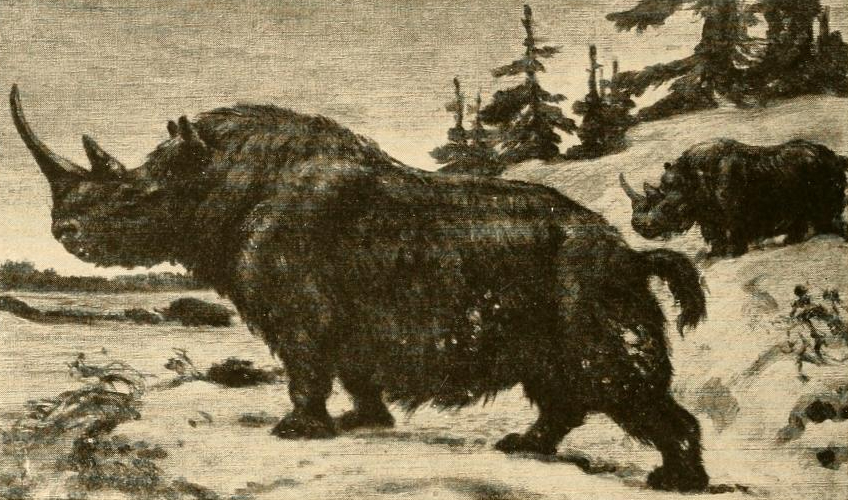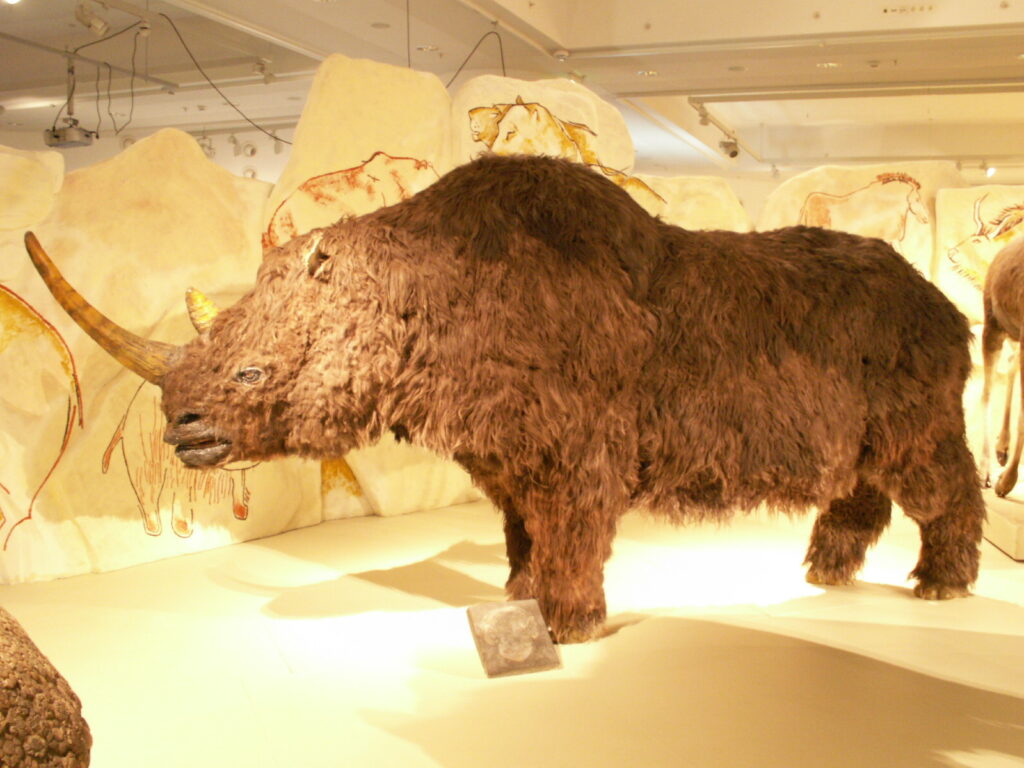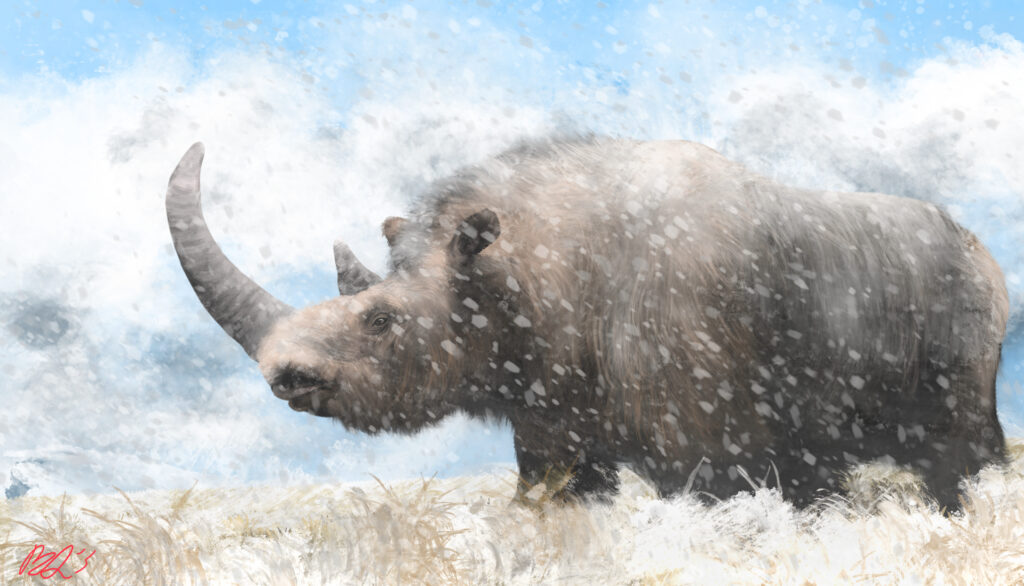The Ice Age conjures images of massive mammoths and saber-toothed cats, but one magnificent beast often overlooked in popular culture deserves equal recognition: the woolly rhinoceros. This formidable herbivore roamed the cold steppes of Eurasia during the Pleistocene epoch, perfectly adapted to harsh glacial conditions that would devastate most modern mammals. With its impressive horn configuration and thick, protective coat, the woolly rhinoceros stands as a testament to evolution’s remarkable ability to engineer survival solutions in extreme environments. Let’s explore this fascinating creature that once shared the landscape with our early human ancestors and discover why this extinct rhino deserves more attention in our understanding of prehistory.
Origins and Evolutionary History

The woolly rhinoceros (Coelodonta antiquitatis) first appeared approximately 3.6 million years ago during the Pliocene epoch in Tibet. Paleontological evidence suggests that these rhinos evolved in the high-altitude plateaus of Central Asia, where they developed adaptations to cold climates long before the onset of the Ice Age. As glacial periods intensified, they gradually expanded their range across northern Eurasia, from the British Isles to eastern Siberia. Their evolutionary journey represents a classic example of how species can adapt to changing environmental conditions over time. Unlike their modern relatives that thrive in tropical environments, the woolly rhinoceros evolved from ancestors that already possessed some cold-weather adaptations, allowing them to specialize further for the harsh Ice Age conditions they would eventually dominate.
Physical Appearance and Size

The woolly rhinoceros was a massive creature, standing approximately 6.6 feet (2 meters) tall at the shoulder and measuring up to 12.5 feet (3.8 meters) in length. Adult specimens typically weighed between 2,000 and 3,000 kilograms (4,400-6,600 pounds), making them comparable in size to the modern white rhinoceros. Their most distinctive feature was an enormous forward-pointing horn that could reach up to 3 feet (1 meter) in length, composed of keratin fibers similar to those in human fingernails. A second, smaller horn sat behind the primary one, creating a formidable defensive arrangement. Unlike modern rhinos with their relatively smooth skin, the woolly rhino possessed thick folds in its hide that added additional protection against predators and harsh weather conditions. Their stocky, barrel-shaped bodies with short legs were perfectly designed for conserving heat in freezing environments.
The Remarkable Woolly Coat

True to its name, the woolly rhinoceros possessed an extraordinary coat that served as crucial insulation against the bitter cold of Pleistocene winters. This thick fur consisted of two distinct layers: a dense, woolly undercoat that trapped body heat and longer guard hairs that protected from moisture and wind. The coat’s coloration likely ranged from reddish-brown to light blonde, similar to other Ice Age mammals like the woolly mammoth. Remarkably well-preserved specimens discovered in permafrost have allowed scientists to study the actual fur, revealing that it grew up to 2 inches (5 cm) thick in winter months. This specialized pelage represents a classic example of convergent evolution, as the woolly rhino developed similar adaptations to other unrelated Ice Age mammals facing the same environmental challenges. The thickness of the coat likely varied seasonally, with some shedding occurring during briefer summer months.
Impressive Horn Configuration

The horns of the woolly rhinoceros represent some of the most impressive natural weapons in the mammalian world. The primary anterior horn could reach spectacular lengths of up to one meter (3.3 feet) and featured a distinctive flattened shape, unlike the conical horns of modern rhinos. This adaptation likely served as a snow-plow in winter months, allowing the animal to sweep away snow to access vegetation buried underneath. The horn’s forward-leaning orientation also made it an effective defensive weapon against predators like cave lions and wolves. Behind this massive structure sat a second, smaller horn that provided additional protection. Cave paintings created by early humans often emphasized these impressive horns, suggesting they were the animal’s most striking feature to our ancestors. Fossil evidence reveals that male woolly rhinos typically possessed larger horns than females, indicating possible sexual dimorphism and use in competition for mates.
Habitat and Geographic Range

The woolly rhinoceros thrived across the mammoth steppe, a vast biome that stretched from western Europe to eastern Asia during the Pleistocene. This cold, dry grassland ecosystem supported an abundance of large herbivores despite the harsh climate. Fossil evidence shows that woolly rhinos ranged from the British Isles across northern Europe, through Russia, and into northeastern China, though they never crossed the Bering land bridge to reach North America. They preferred open tundra and grassland environments where their size and feeding adaptations gave them advantages over other herbivores. During the coldest periods of the Ice Age, their range would contract southward, expanding again during interglacial periods. Unlike some cold-adapted megafauna that ventured into North America, the woolly rhinoceros remained exclusively Eurasian throughout its evolutionary history, occupying ecological niches similar to those of modern musk oxen and reindeer.
Dietary Adaptations

As a specialized grazer, the woolly rhinoceros evolved remarkable adaptations for feeding on tough tundra vegetation. Its elongated skull featured a distinctive downward-sloping profile that positioned its mouth closer to the ground, allowing efficient grazing on short grasses and herbs. The rhino’s wide lips could crop vegetation close to the soil surface, while its high-crowned teeth were perfectly designed for processing silica-rich grasses that would quickly wear down the dentition of less-specialized herbivores. Analysis of preserved stomach contents from frozen specimens has revealed that their diet primarily consisted of grasses, sedges, and flowering tundra plants. Their feeding strategy required them to consume large quantities of relatively low-nutrition vegetation to maintain their massive body size. Studies of stable isotopes in fossil teeth confirm they were primarily grazers rather than browsers, distinguishing them from some of their modern rhino relatives that prefer to eat leaves and branches.
Social Behavior and Reproduction

While direct evidence of woolly rhinoceros social behavior remains limited, researchers can make educated inferences based on fossil distribution patterns and comparisons with modern rhino species. The woolly rhino likely lived a predominantly solitary lifestyle, with adults coming together primarily for mating purposes. Females probably had extended periods of maternal care, giving birth to a single calf after a gestation period similar to modern rhinos (approximately 16-18 months). Cave paintings occasionally depict small groups, suggesting some temporary aggregations may have occurred in resource-rich areas. Sexual maturity was likely reached between 5-7 years of age, with a total lifespan potentially reaching 30-40 years in favorable conditions. Like modern rhinos, males may have engaged in competitive behaviors for mating rights, potentially using their massive horns in ritualized displays of dominance rather than in direct combat that could prove fatal with such formidable weapons.
Remarkable Fossil Discoveries

The scientific understanding of woolly rhinoceroses has been dramatically enhanced by several extraordinary fossil discoveries preserved in permafrost. The most famous specimen, discovered in 1929 in Starunia, Poland, retained not just bones but also soft tissues, including skin, fur, and internal organs. This remarkably well-preserved individual, known as the “Starunia rhinoceros,” provided unprecedented insights into the species’ external appearance and anatomy. In 2007, another groundbreaking discovery occurred when a juvenile woolly rhino nicknamed “Sasha” was found in Siberia with intact fur, ears, and even eyelashes preserved. More recently, in 2020, an exceptionally well-preserved carcass emerged from melting permafrost in Yakutia, Russia, with much of its soft tissues intact after more than 20,000 years. These frozen specimens have allowed scientists to extract DNA, study stomach contents, and analyze tissue samples, providing a uniquely detailed picture of an extinct animal that would be impossible from skeletal remains alone.
Interactions with Early Humans

The relationship between woolly rhinoceroses and early humans provides a fascinating glimpse into prehistoric human-wildlife interactions. Cave paintings discovered across Europe, particularly in France’s Chauvet Cave (dating to approximately 30,000 years ago), depict woolly rhinoceroses with remarkable accuracy, suggesting they made a profound impression on our ancestors. Archaeological evidence indicates that while humans did hunt these massive creatures, they did so relatively infrequently compared to more common prey species. The dangerous nature of confronting such a powerful animal likely made rhino hunting a particularly prestigious achievement for Paleolithic hunters. Some archaeological sites contain rhino horns and bones that appear to have been used in ritual contexts, suggesting these animals may have held spiritual significance. Evidence of tool-making using rhino bones has been documented at several Paleolithic sites, demonstrating that humans utilized these animals not just for food but also for materials when hunting was successful.
Extinction: Causes and Timing

The extinction of the woolly rhinoceros remains a subject of ongoing scientific debate, with multiple factors likely contributing to their disappearance. Most populations vanished approximately 14,000 years ago, coinciding with the warming climate at the end of the last Ice Age. This climatic shift transformed their preferred steppe habitat into forests, dramatically reducing available grazing areas. Simultaneously, human populations were expanding across the rhino’s range, potentially increasing hunting pressure on already stressed populations. Recent genetic studies suggest that inbreeding and reduced genetic diversity may have compromised the species’ ability to adapt to changing conditions. Interestingly, isolated populations on Wrangel Island off Siberia’s coast survived until approximately 9,000 years ago, similar to the pattern seen in woolly mammoths. This extinction pattern aligns with the broader disappearance of Pleistocene megafauna worldwide, suggesting a complex interplay of climate change and human activity rather than a single decisive factor.
Ancient DNA Revelations

Recent advances in paleogenomics have revolutionized our understanding of the woolly rhinoceros through the successful extraction and sequencing of ancient DNA. In 2020, scientists published the first complete mitochondrial genome of the woolly rhinoceros, extracted from a 14,000-year-old specimen found in Siberia. This genetic material has revealed surprising relationships with other rhinoceros species, confirming the woolly rhino’s closest living relative is the Sumatran rhinoceros. Genetic analysis suggests the woolly rhinoceros maintained stable population sizes until relatively close to their extinction, contradicting earlier theories about long-term population decline. These studies have also revealed unexpected genetic adaptations related to cold tolerance, including genes associated with hair growth, fat metabolism, and temperature sensitivity. Perhaps most interestingly, genetic evidence indicates the woolly rhinoceros had effectively adapted to previous warming periods, suggesting their ultimate extinction may have been more complex than simple climate sensitivity and possibly involved increased human hunting pressure or disease.
The Woolly Rhino in Popular Culture

Despite its impressive nature, the woolly rhinoceros has received considerably less attention in popular culture than contemporaries like the woolly mammoth or saber-toothed cat. When featured in media, it often appears in Ice Age documentaries like “Walking with Beasts” and animated films such as “Ice Age,” though typically in supporting roles rather than as central characters. Museums worldwide showcase woolly rhinoceros reconstructions, with particularly impressive displays at the Natural History Museum in London and the Paleontological Museum in Moscow. These exhibits often feature full-size models with scientifically accurate fur coverings based on preserved specimens. The species has inspired numerous artistic recreations by paleoartists like Mauricio Antón and Charles R. Knight, who strive to depict these animals as they appeared in life. Despite this relative obscurity compared to other Ice Age megafauna, the woolly rhino’s distinctive appearance makes it instantly recognizable when featured in educational contexts, helping modern audiences connect with this remarkable vanished species.
Conservation Lessons from an Extinct Giant

The extinction of the woolly rhinoceros offers valuable insights for modern conservation efforts, particularly regarding the five surviving rhinoceros species, all of which currently face serious extinction threats. The woolly rhino’s disappearance demonstrates how even highly successful species that dominated their ecosystems for hundreds of thousands of years can rapidly vanish when faced with multiple simultaneous challenges. Climate change and human activity—the same factors implicated in the woolly rhino’s extinction—continue to threaten modern rhinos, albeit in different forms, like habitat destruction and poaching. The genetic studies revealing reduced diversity in woolly rhino populations before extinction parallel concerning patterns in modern rhino species like the Javan rhinoceros. Conservation strategies for modern rhinos increasingly incorporate genetic management to maintain diversity, directly applying lessons from paleogenetic studies of their extinct relatives. Perhaps most importantly, the woolly rhinoceros reminds us that extinction is permanent—once a species vanishes, its unique evolutionary adaptations and ecological role are lost forever, emphasizing the urgency of current conservation efforts.
Conclusion

The woolly rhinoceros deserves recognition as one of the most remarkable mammals to walk the Earth during the Ice Age. Its extraordinary adaptations—from its impressive horns to its insulating coat—demonstrate nature’s ingenuity in the face of extreme environmental challenges. Through remarkable fossil discoveries and cutting-edge genetic analysis, scientists continue to uncover new details about this prehistoric giant, helping us understand not just the animal itself but the entire ecosystem it inhabited. As we face current biodiversity challenges and climate change, the story of the woolly rhinoceros serves as both a fascinating glimpse into our planet’s past and a sobering reminder of how quickly even the most successful species can disappear. In studying these magnificent creatures, we gain perspective on our place in Earth’s long biological history and our responsibility to protect the remaining megafauna that still share our world.




